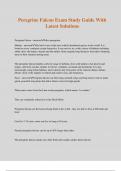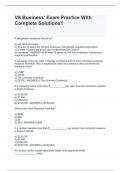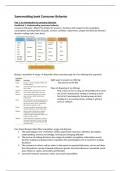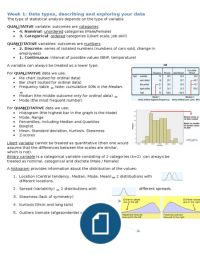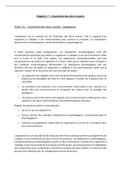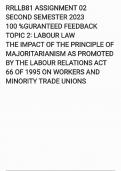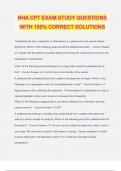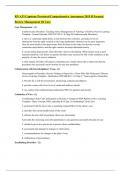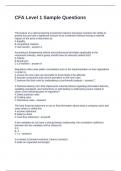Experiments aim to measure the effect of the independent variable
on a dependent variable.
What is an experiment?
'
Variables (dependent, cause effect
independent, control)
: Samples
IV DV
Independent: variable you E.g time of day Memory
Hypothesis manipulate Caffeine recall
: Results (graphs) Dependent: variable you consumption Concentra
Control measure Sleep tion
I
Fairness Control: variable that keeps
-
Ability to replicate the same
Extraneous variables:
variables which have not
been controlled for and
which could impact the DV
Experimental Methods
Laboratory experiment: The researcher manipulates an independent variable to measure its effect on a dependent
variable; this carried out in a carefully controlled (often artificial) environment which has been set up for the purpose
of research.
Advantages: Disadvantages:
-
Tested in consistent /
Lacks mundane realism (low
, environment "
Extraneous variables are I
ecological validity)
identified and controlled
i Artificial
Field experiments
Biased due to sampling
Conditions of IV are naturally occurring. TheEthical problems
experimenter of decide who is in which condition/ cannot
doesn’t
manipulate the IV directly. The dependentDisadvantages:
variable is still measured.
Advantages: deception
,
High in ecological validity
"
More bias due to
i
Less sampling biased °
Demand
Difficult tocharacteristics
replicate
- Difficult to record data
Unethical problems of
consent/ withdrawal
/
Quasi (kwaysee) / natural experiment:
The researcher tests the effect of an IV on a DV in a highly controlled environment. IV is changed by natural
occurrence.
Advantages: Disadvantage:
-
High in ecological validity ,
Hard to infer cause and effect due to little control over
, Little sampling bias or demand "
extraneous variables
characteristics Almost impossible to replicate
: Ethical problems of consent/ deception
Bias of volunteers being aware of being studied due to
Experimental Designs demand characteristics
Independent measures design: An independent measures design consists of using different
participants for each condition of the experiment.
Strengths: Weakness:
No problem with order
,
" Risk of individual Order effects: Confounding
effects differences
r
variable arising from the order in
Double the amount of which conditions are presented
participants so time (counteracted by using
consuming counterbalancing)
Repeated measures design: a repeated measures design consists of testing e.g. Boredom, Fatigue, Practice
the same individuals on two or more conditions of the experiment
Strengths: Weakness:
, Removes risk of individual " Order effects
differences -
Attrition Attrition: people who leave/ drop
out of research (usually a long-
term study) for example because
You can counterbalance to try to reduce order effects by swapping conditions they moved country or felt their
for each group of participant. privacy was invaded.
Matched Pairs design: A matched pairs design consists of using different participants for each condition of
the experiment but participant variables are controlled by matching pairs on a key variable (characteristics).
E.g.Strength:
match participants with a similar IQ for memory recall tests
Weakness:
Removes order effects
" Time consuming
I
Difficult
.
Hypotheses
It states what you believe to be true (a prediction). It is a precise and te stable statement of the relationship between
two variables.
They are only written for experiments and correlations
Null hypothesis
This states that the IV has no effect on the DV e.g. there will be no different on memory recall based on noise levels.
You must write a null hypothesis to be able to make accurate statistics for your results and to be able to compare.
Alternate/ experimental hypothesis
This is what you expect to find. There are two types of alternate hypothesis:
One tailed (directional): you predict the effect and direction of the results
Two tailed (non-directional): you expect to find an effect but you do not state its direction
, Creating an experiment
1. Writing an aim- The aim is to investigate whether [state
IV] affects [state DV]
E.g. the aim is to investigate whether time of day affects
memory
2. Writing a research question- Does [state IV] affect [state When creating an experiment
DV]?
Does noise affect memory? consider:
E.g. does time
Research aim: of
theday
aimaffect
is to memory?
investigate whether noise affects memory Research aim
Sample: sixth form register, number each student, random number generator. Sample
30 students from year 12 and 13. 60 students overall IV- including details on
IV: noise type (silence, classical music, chatter) conditions
DV: memory recall- 20 words in 1m (amount of correct words) DV- how specifically are you
Controls: same words, how many words, time of day measuring this?
Experimental method: laboratory (control extraneous variables, cause and Controls
effect is more accurate) Experimental method- justify
Experimental design: independent measures design (no order effects) your choice
Experimental design- justify
Procedure: school provides data for sixth form register, register each name your choice
into a random number generator for each year group, use for 30 times for Bullet point procedure
each year group, giving an overall 60 students. Use random name generator
to separate into a further 3 groups for each year group, containing 10
students in each group. Combine each group of 10 from year 12 and 13 and
put the three groups of 20 into three different classrooms. Set a condition for
each room (silence, classical music, chatter/background noise). Project a list
of 20 words on the board for 1 minute, asking the students to revise them. 1
minute of free recall in silence. Collect results and mark. Compare three
categories and state conclusion.
Hypothesis:
I predict that there will be an effect on memory from the level of noise and the direction of the results will
favour the condition of silence. Participants in the silent condition will overall have better memory recall than
the participants in the noise conditions.
Writing fames for hypotheses
There will be no difference in [state DV] (as measured by{copy how it was measured from the
Null
scenario}) in the [state condition] (in which participants {copy what was done during this
condition from the scenario}) compared to [state other condition] (in which participants [copy
what was done during this condition from the scenario}). Any difference which occurs will be
due to chance.
Participants will have significantly higher/better/faster [state DV] (as measured by {copy how it
Alterna One was measured from the scenario}) in [state condition] (in which participants {copy what was
te taile done during this condition from the scenario}) than in [state other condition] (in which
participants {copy what was done during this condition from the scenario})
hypoth d
esis
There will be a significant difference in [state DV] (as measured by{copy how it was measured
Two from the scenario}) in the [state condition] (in which participants {copy what was done during
taile this condition from the scenario}) compared to [state other condition] (in which participants
d [copy what was done during this condition from the scenario}).

